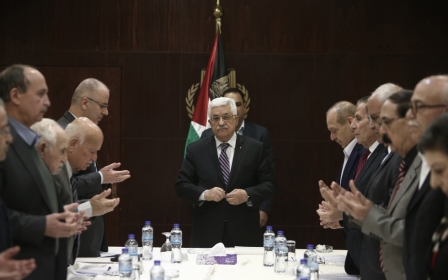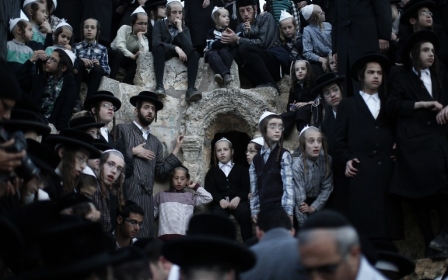Palestinian citizens of Israel march against Independence Day
HADATHE, Israel - It’s Israeli Independence weekend, and the whole country is decked out in flags. Stars of David hang from streetlamps and stream on miniature antennae behind cars; there are patriotic street parties and TV shows, bunting, and stores sell inflatable hammers striped with the nation’s colours.
But at the site of the destroyed village of Hadathe in northern Israel, there has been no blue and white. Instead, countless Palestinian flags were held above a crowd of several thousand, pulled taut by a relentless wind on Thursday afternoon. On a plateau where cropped cornfields overlook Lake Tiberius, a crowd - composed mostly of Palestinian citizens of Israel but with a few Jewish Israeli activists, too - wore Kuffiyehs and held banners that proclaimed Palestinian identity and the right to return.
"I come here to belong, and to feel I belong. To remember the past. And to show that things will be different. I need to feel that I am Palestinian," Badia Yunis, who attended the event, told Middle East Eye. Yunis is from the village of Ara just down the road from the protest site.
“The most important thing about what I want to say, I think, is this: I have been here, I am here, I will be here," he added assuredly as he braces himself against the wind.
Thursday marked the 18th Annual March of Return, a commemoration of the displacement and expulsion of Palestinians that took place in 1948 but the occasion is an extremely polarized one here. While the Israelis celebrate this time as the moment they won their national independence, the Palestinians see it as the start of the Nakba – the catastrophe that marked the tearing apart of historic Palestine and its replacement with the Israeli state.
For those that attended Thursday’s demonstrations, the issues at stake were all, in some way, related to this first catastrophe.
The grievances of Palestinian citizens of Israel, who today make up some 20 percent of the country's population, range from discrimination in employment as well as housing and infrastructure to the kind of racist rhetoric heard during last month's general election, when President Benjamin Netanyahu warned of “Arabs voting in droves”. The fact that, since 1948, this minority have been just that in a state that sees itself a national home for the Jewish people and even a Jewish state has been at the heart of all those grievances.
“I’m here because I feel I am related to this country, and I don't accept Israel," Yunis’ daughter, 18-year-old Reem, said. Her kuffiyeh is wrapped round a coordinated hijab, and she helps her father with his English. "From 1948, I feel there are people who feel here in a very strange, weird, way, because you’re meant to feel, to relate to, someone who took what is yours."
The event the pair attended, organised by the Association for the Defence of the Rights of the Displaced People (ADRID), an NGO, centred on one particularly decisive element of 1948. It took place in Hadathe, one of the many villages that disappeared in the course of the creation of the state of Israel.
In 1948, the residents of this community and other villages like it were scattered to camps in Lebanon, Syria, Jordan and the West Bank; many were also displaced to other areas of Israel, where their descendants still live in villages and cities. But while some have stayed, few have been able to go back to their original homes. At the protest attendees were keen to vocalise this key Palestinian demand and stressed that those who have been displaced - both internally and outside Israel’s current borders - should be given the right to return to their homes.
“We came here to call for the Palestinian refugees' right of return, for the right of return for refugees who crossed the border and the internally displaced too,” Mohammed Kayyal, a founder of ADRID, told Middle East Eye. “The Right of Return is the crux, the heart of Palestinian rights. We are talking about self-determination, the implementation of other rights, but most of all we're talking about the right of return.”
Like many at the commemoration, Kayyal's family come from a destroyed village, al-Birwe. In 1948, Kayyal’s father and mother were expelled from the town with the rest of the population. Most of the village, including the church, mosque and houses, was destroyed, although the cemetery and school still stand.
“My father and mother, it was everything for them, until the last days of their life, it was a dream to return,” Kayyal, who was born after the Nakba in the village of Judaida, 2km away, explained. “For them, al-Birwe was childhood, school, family, farm, childhood friends and relatives. We were expelled and prevented physically and by military force from returning. In many villages, there were massacres perpetrated against Palestinians.”
“We are now internally displaced refugees living in densely populated areas,” he continued. “The town is so densely populated, partly because it's so full of internally displaced people. We are without land, and we are impoverished. It’s legitimate that we have the chance to work as farmers, that we have land available to build flats, to have space for the youth to build their new homes. It is our right to return to our villages and towns, from where our fathers and grandfathers were expelled. We want to get back our lands, our farms, our property, and to live there.”
Despite the challenges faced by internally displaced people, however, their fate is often overlooked in comparison to those Palestinians who fled beyond the borders of Israel. This phenomenon has in part been encouraged by both the strangeness of the situation and the relatively extreme situation faced by those living in refugee camps in Lebanon or Syria. It was that ignorance of internally displaced people that compelled Kayyal and others to form ADRID in 1992, after the Madrid Peace Conference.
“Nobody talked at that time about internally displaced people,” said Kayyal. “So political and social activists established a community that included representatives from different displaced villages. We published a leaflet and campaigned for the right of return to our villages and restitution of property.”
The story of the Palestinian citizens of Israel is a varied one that has shifted over the decades. Between 1948 and 1966 Palestinians in Israel were granted citizenship but lived under varying degrees of military rule.
It took a while for internally displaced people to begin organising for their rights. In the years following 1948, most of the displaced believed they’d be able to return to their homes, and lived in a state of limbo for years or even decades after the event.
Those who remained inside Israel's borders in 1948 were given citizenship and voting rights, and during its first few decades the new state met little resistance from the minority. It wasn't until the 1960s, and particularly after Israel occupied the West Bank and Gaza in the Six Day War, that the Palestinian national identity and resistance to Israeli rule began to be openly expressed.
Working with and speaking to those living in the occupied territories, Palestinian citizens of Israel began to more clearly protest discriminatory policies and became key figures in the Palestinian struggle. More recently, protest by Palestinians within Israel has become even more visible, with regular marches and camps at destroyed villages, student mobilisation and successes in last month's national election, too.
Now, given the Orwellian label “present absentees”, internally displaced people are estimated by the Resource Center for Palestinian Residency and Refugee Rights (Badil) to make up 12.8 percent of the Palestinian population in northern Israel, 20.5 percent of the central area and 22.7 percent of the south. (While there is a large proportion of Palestinian citizens in Israel who live in the north, they suffered the least amount of forced relocation, which helps to account for the discrepancy.)
In recent years, the fate of these internally displaced populations has become a central focus of action for Palestinians living within the borders of Israel. So-called “returns” to the town or village of their origin by the children and grandchildren of internally displaced people have drawn significant attention, particularly in villages like Iqrit, Kufr Birim and al-Ruways. This time last year, the March for Return in Lubya attracted more than 10,000 people.
While this year did not attract so many attendees as the last, the organisers of the event remain positive.
“[Israel’s first Prime Minister] Ben Gurion thought that after 50 years all the refugees and internally displaced people would forget their village of origin. But every year we have more and more young people coming to events like these,” Kayyal said. “The biggest showing at these kind of events is from the youth. The overwhelming majority are not the displaced themselves but their sons and daughters, granddaughters and grandsons of the displaced.”
At Hadathe, Kayyal's observation rang true. Young people arrived with their families, but also in groups of friends, or as part of organisations made of Palestinians from specific destroyed villages. Many of the organisers were students, and young people were visible volunteers at the stalls and presentations of Palestinian culture that dotted the edges of the protest site, too.
"As Arabs were here first - we have to save our history," Bashar Ali, 18, told Middle East Eye. "And now we are here to support the Palestinian people who were displaced in 1948."
"It still hurts," his friend, 24-year-old Manar Mansor, who attended the demonstration with her 18-year-old sister Nawaz, continued. "It’s a disaster, a big disaster – not like something we can forget."
Middle East Eye propose une couverture et une analyse indépendantes et incomparables du Moyen-Orient, de l’Afrique du Nord et d’autres régions du monde. Pour en savoir plus sur la reprise de ce contenu et les frais qui s’appliquent, veuillez remplir ce formulaire [en anglais]. Pour en savoir plus sur MEE, cliquez ici [en anglais].




